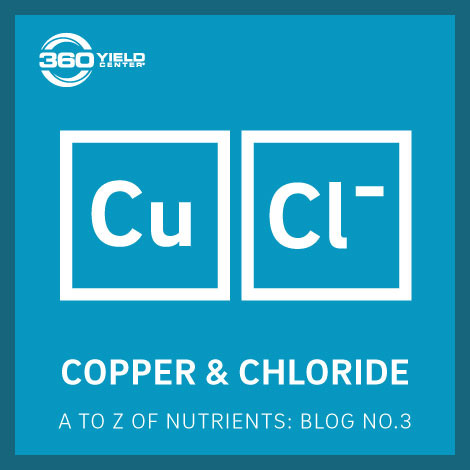In a way, Iron and Molybdenum act quite differently in relation to the soil. Molybdenum (Mo) becomes more available as the pH levels in your soil increase, while Iron (Fe) is quite the opposite and becomes more available at lower pH levels. These two micronutrients are a great example of why a balanced pH is…
A to Z of Crop Nutrients: Copper (Cu) and Chloride (Cl)
Chloride (Cl) is taken up by the plant in the Cl- form. Because soil is negatively charged, Cl- can be mobile and leach in soils. Cl- is thought to be a driver in stomatal regulation, which helps control water levels in the plant. Therefore it is an important element in helping regulate water loss and…
A to Z of Crop Nutrients – Thinking Small
Because primary and secondary nutrients are required by the plant in larger amounts, they’re often a limiting factor in crop production. However, the combination of higher intensity soil sampling with data anlysis and mapping programs allow us to have a much deeper understanding of how and when to rectify fertility issues. This reduces the chances…
A to Z of Crop Nutrients – The Basics
This is the first of a series of blogs focused on crop nutrients. The first part of the series will deal with the actual nutrients themselves and then we will dive into concepts such as CEC, pH, liming, soil structure and other concepts. There are seventeen known chemical elements that are critical for plant growth…
Warm, Wet Conditions Affect Pre-Plant N Application
While we all enjoy the warm fall weather, these warm temperatures in conjunction with a delayed soybean harvest create some issues for growers intending to apply fall anhydrous. Most growers understand the importance of waiting until soil temperatures have dropped below 50 degrees in order to dramatically slow the conversion of ammonium nitrogen to the…
3 Things to Consider Before Applying Fall Anhydrous
Many growers will head to the field this fall to apply anhydrous, in the interest of spreading the workload and saving money on input. Here are 3 things to consider before applying anhydrous this fall: 1. The weather next year – You’re probably asking yourself, “who in the world knows what the weather is going…
The N Factor: No More Crystal Ball
Although harvest and tillage are in full swing in many areas, preparation for the 2017 planting season is top-of-mind for many growers. Things like seed purchases, equipment plans, herbicide programs and fertility decisions are made well before the crop is dried. The fertility decision is a critical process that requires intense scrutiny as many growers…
A New Perspective on Plant Health
A few interesting developments have occurred over the past 12 months that are changing the way we manage particular issues in the Midwest. An open letter from several university entomology departments in the Great Lakes region discusses concerns regarding the Cry1F protein (Herculex 1, TC1507) as it relates to control of the Western Bean Cutworm….
Sign Up Now! 2016 Yield Book Early Release Request Form
Want to receive 2016 Trial Data as it comes in? Simply click here and fill out the form to receive PDFs via email. If you would like a printed copy of the 2016 Yield Book mailed to you once completed in early 2017, please include your mailing address. …
Wet or Dry, N Placement Matters
During the 2015 season many growers experienced wet to excessively wet conditions. This led to extensive loss of nitrogen due to denitrification and/or leaching in many fields. Growers that were able to apply supplemental N last year often reaped very large rewards for additional midseason N applications. Fast forward to the 2016 season and many…








